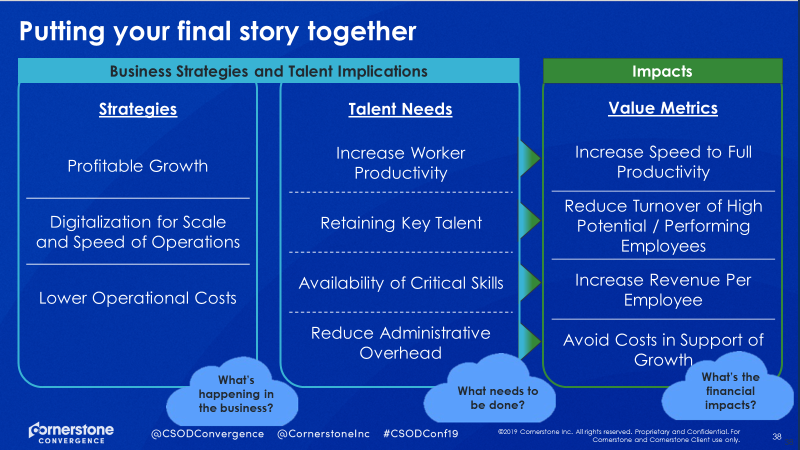
If you are an L&D leader, one of your most pressing issues is probably showing the impact of what you do on business results.
For most of the learning leaders we meet, the challenge is that business leaders want the answer in value. They want to know what they are getting for their L&D spend—What's it worth?
We have had a long conversation about learning measurement for the past few decades. We have developed and used many learning evaluation models that lead us through a series of questions. One of the most popular is the Kirkpatrick model:
- How well did we satisfy the learning participants?
- Did they gain the intended knowledge, skills, attitude, confidence, and commitment?
- Do they apply what they learned on the job?
- Did we achieve the intended outcome?
The fourth question is where things fall apart because the defined outcome is usually not what excites your CEO. That makes it nearly impossible to show impact on the business.
When we talk with L&D leaders about that measurement challenges, the conversation usually centers on three questions:
- Why should we measure the impact on the business? Isn't helping people develop and become more proficient enough?
- What should we measure?
- How can we measure it?
In this article, we will answer all three questions and give you a roadmap to answering the CEO's question—what's it worth?
Why Measure the Impact of Learning?
Doug Gray, Ph.D., Founder and CEO of Action Learning Associates, LLC, recently spoke at a Phenom Cloud Webinar about L&D's alignment to organizational objectives. He began with the question: "What's your purpose?"
Your purpose right now might be to survive the pandemic. It could be to grow revenues in the next year by 10%. It might be to keep your family safe through the pandemic.

The problem is that when you ask L&D in most organizations what their purpose is, they usually focus on their core mission—not on business results. Doug recently partnered with John R. Mattox, II, Ph.D., Vice President of Action Learning Associates, in a survey that showed only 37% of respondents said the L&D purpose was related to achieving business goals.
Dr. Gray's point is that we are too often focused on operational objectives rather than aspirational goals. Business goals differ between industries and individual businesses, but their common theme is aspiration:
- Reduce operational costs by 8% June 1, 2021.
- Grow sales revenue by 7% in 12 months.
- Capture 18% of the South American market by the end of 2021.
If your purpose were one of these, what would you do to achieve that purpose? How would you measure what you do?
Regardless of what goal system you use, goals should link directly to organizational purpose. The alignment helps everyone work toward the organization's purpose and goals.
The function of measurement is to quantify the achievement of that purpose.
What Do We Measure to Show Learning Impact?
Deciding what to measure is a matter of aligning strategies, talent priorities, and value metrics, says Ed Turi, MBA, Principal Value Consultant for Cornerstone OnDemand. In our webinar, he walked through an alignment process that aligns business strategy and talent priorities with quantifiable results:
- Business strategy: what's happening in the business? What is the business focus?
- Talent Priorities: what needs to be done? Who will do it? What skills does it require?
- Value Metrics: what's the financial impact?

Value metrics are where a lot of organizations get stuck. L&D is accustomed to measuring efficiency and effectiveness, but not value. You may not have access to the data, but that doesn't mean you can't get it. As we will see, it is often a matter of getting the right people on your team.
Where you start depends on your organization maturity level:

- Essential: what you are required to measure.
- Efficient: reducing transaction costs, eliminating process duplication, reducing administration time.
- Effective: doing what you do better.
- Transformational: Changing business outcomes.
Ed Turi's point is this: Doing the essential, efficient, and effective won't get your top executives' attention. Those things are what you are expected to do—minimum requirements.
What gets your leaders excited is having a transformational effect on:
- Revenue: market share, wallet share, customer retention
- Profitability: reduce defects, increase margins
- Productivity: revenue per employee
A 5% reduction in HR staffing costs gets you a yawn. A 5% increase in revenue makes you a hero.

Here is an example of what you might develop as your final measurement story.
When you are considering what to measure, start from where you are, but keep in mind the goal—not only value for HR or the business but also for the executives responsible for creating value for stakeholders.
How to Measure Learning Impact
Our purpose here is not to work through all the computations you need to calculate your value metrics. We do that in our workshops, but let's focus now on the framework and the process.
The first thing to do in working on learning impact measurement in your organization is to get the right people together. Everyone in your organization has a stake in the learning, even if they don't realize it. We recommend creating a cross-functional team.
A Framework for Collaboration and Governance
Your framework's actual structure will depend on your organization and culture, but we can give you a starting point for thinking about whom you need on your team. Putting a team together can give you the capabilities you don't have. It can be a vehicle for engaging the organization in change management for adopting fresh ways of looking at learning in the organization. And it can help you break down organizational silos.
Consider these organizational functions as you build your team:
Operations. These are the people who own organizational objectives and are often the ones who drive the training plan's execution. The objective, KPI, OKR owner should have a leadership role on your team. They have the data you need to show impact and can play a key role in evaluating and estimating learning contribution to business results. If you include them in your planning, you make them a partner in the result.
Finance. Not only does your finance representative have expertise in financial acumen, budgeting, and procurement (should you need technology or other resources), but that person will also have access to top-line business metrics. If you are engaged in a project that requires financial calculations and budgeting, a finance team will help you get things done the way the CFO wants them.
IT. You may not need help from your technology team, but if you do, it is IT may have the resources you need and can help you efficiently use your infrastructure.Analytics. If your organization has data scientists, analysts, and data wranglers, you may lean on them for help instead of hiring expensive expertise.
Learning Experts. Your go-to resource for educating your team on learning science and methods.
HR. You are considering initiatives that will affect revenue, profitability, and productivity, and will need participation from people who manage each link in the talent value chain. HR owns the chain from onboarding to offboarding.Marketing and Communications. You can learn a lot from the people who capture the attention and wallets of your customers. Crafting a persuasive message requires skills that take years to develop, and you have that expertise inside your organization. Communication can help you get that message to the right people using the most effective medium.

The Measurement Process
The method for putting the measurement plan in place is a standardized process to organize, plan, and execute your measurement strategy. This method, developed by Sasi Kalagara at PhenomᵉCloud, has produced results for dozens of customers around the world.
Form a Cross-Functional Team
Get multiple perspectives to keep from developing an insular focus. Getting other people involved will break down many barriers.
Start With A Specific Goal
Useful measurement starts with a specific goal, based on a question your organization is asking itself. Over the past years, we have discovered that small, targeted efforts give you a quick return on your investment. In the early days of people analytics, leading companies made considerable investments in capturing all their people data and trying to make sense of it in one massive project. They said they needed to analyze all the data to find the story the data were trying to tell them.
That turned out to be precisely backward. Their efforts didn't pay off for years, if at all.
Understand the Data To be successful, you must understand your data. You can do that by asking three questions:
- What do we know now, based on the data we have?
- What more do we need to know to answer our question? When you think this through, don't spin your wheels trying to capture everything. Get as much data as you need and not one bit more.
- Where and how will we get the data we don't have? Again, don't waste time and effort on gathering data you don't need. Less is more.
Brainstorm and Agree on Metrics, OKRs, or KPIs All you want to do is brainstorm what you can measure. Don't discuss alignment at this point; it will bog you down. Just identify useful measures.
When you've agreed on what to measure, use a whiteboard or sticky notes to align them with business objectives.
Eliminate the ones that don't support business objectives.
Develop Reporting Instead of giving stakeholders like the executive team, managers, and HR reports to analyze. We recommend giving them dashboards where they can see what's going on at a glance. Most reporting platforms give you the tools to create dashboards and visual reports. If your system can't do that or needs help, call us. We'll help you find the right solution.
Communicate to All Stakeholders Keep everyone in your organization, from top executives to the newest employee, informed about what you are doing and what it means for them. Lean on Marketing to help you with communications.
Start Today
we a show, you can get started now with the resources you have. Look at what you're planning now to solve a business problem. Choose an initiative that will not tax your resources, but will impact revenue, profitability, or productivity. Make that project your entry into the world of measuring learning impact.
Don't avoid a project, because you don't know how to measure it yet. You will learn.
Lean on your team. Use the tools that Doug, Ed, and Sasidhar gave you. If you get stuck, contact them or Sean Teague at
PhenomᵉCloud is a full-service technology company dedicated to helping clients solve business problems, improve the capability of their people, and achieve better results.


Leave a Comment